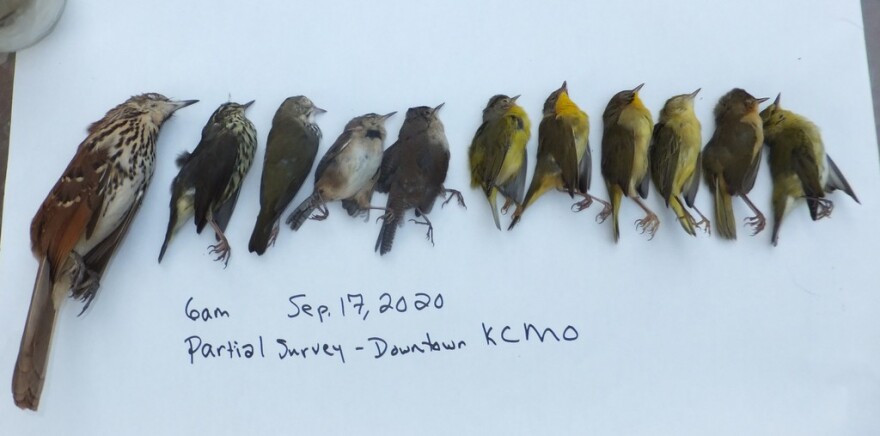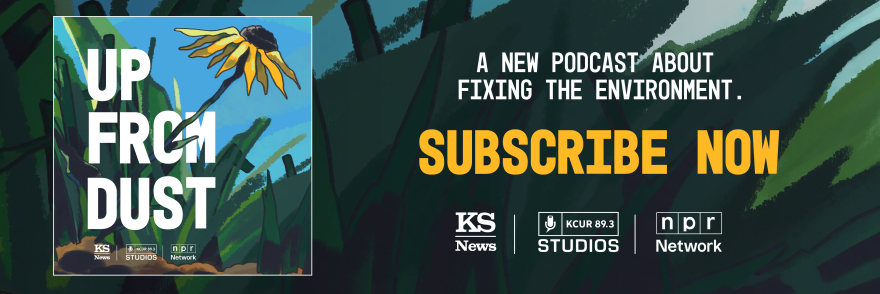A new report from Bird Safe KC gives a peek into one of the top challenges that birds must navigate during their spring and fall migrations through the metropolitan area — windows.
Over the past six years, dozens of volunteers have checked buildings in downtown Kansas City, Missouri, and other areas for birds that die after hitting glass.
They’ve tallied nearly 1,900 carcasses — a small sample of what scientists say is a much larger problem.
Scientists estimate that more than 1 billion birds die each year in the U.S. by slamming into human-made structures. Spring and fall migration are particularly vulnerable times for the creatures, including the many millions that fly through Kansas and Missouri on their journeys.
The annual death toll alarms conservationists because birds play a key role in the food web and in shaping their habitats.
“They’re seed dispersers, they’re pollinators, they keep our insect populations down,” said Tessa Poolman, who directs community conservation programs for the Missouri River Bird Observatory. “Not only that, but they’re just a joy to see.”
This last reason offers another benefit, she said. It contributes to human wellbeing.
“They help connect people to other nature and other outdoor things,” Poolman said, “which we need more of.”
The Missouri River Bird Observatory coordinates the Bird Safe KC project.
The group aims to educate building owners and managers that windows can be treated — such as by applying a transparent, dotted adhesive film – to help birds recognize glass as a solid surface.

Homeowners can also help. The American Bird Conservancy website lists options that reduce bird fatalities. Some are quick do-it-yourself projects. Others require purchasing special products, such as that adhesive film.
People can see the film, and other treatments, on windows at Johnson County Community College and at the Burroughs Audubon Nature Center and Bird Sanctuary.
People who live in the Kansas City metropolitan area can also contribute to Bird Safe KC’s data collection by reporting bird collisions at home or at other buildings through the project’s website.
Midcontinent hazards for birds
In the Kansas City metro, most of the dead birds found by volunteers since 2019 have been migrating species. These birds were either passing through or had newly returned from other regions where they spend part of the year.
Two of the most frequently found birds include the strikingly black-masked common yellowthroat warbler and the white-throated sparrow, a little brown bird that whistles a tune known to bird lovers as “Oh Sweet Canada.”
Seven of the U.S.’ top 10 riskiest cities for migrating birds each spring are in the middle of the country, according to a 2019 study published in Frontiers in Ecology and the Environment.
These cities, which include Kansas City and St. Louis, pose such a challenge to birds because their light pollution and buildings fall within critical migration paths.
“The lighting is what attracts the birds down out of their migration,” Poolman said.
The next morning they search for food and water in the city and some slam into windows, confused by reflections of vegetation and the sky.
Although birds strike buildings year round, this is why the death toll increases in the spring and fall.
Drawing attention to light pollution in the Midwest
It’s also why Lights Out movements are gaining traction in some U.S. cities, in which people turn off non-essential lights during migration season.
In Missouri, Kansas and neighboring states, Lights Out Heartland promotes this initiative. It’s a project led by DarkSky Missouri.
In recent years, Bird Safe KC has heard more and more anecdotes about local building owners and managers turning off non-essential lights during migration. But it’s unclear how many properties participate.
Meanwhile, the Kansas City Council last week adopted a resolution recognizing International Dark Sky Week.
“We’ve also asked the city manager to turn off the lights from sunset to sunrise,” council member Johnathan Duncan said at the meeting, “to ensure that we are protecting those migratory birds.”
Council member Melissa Patterson Hazley said she appreciated the attention to the value of preserving night skies.
“A lot of people just don’t know how important it is to wildlife and the larger ecosystem that we depend on as humans,” she said. “I will be turning off lights outside for a period of time in solidarity.”
A city spokesperson later confirmed by email that staff are turning off the exterior lights at City Hall from sunset to sunrise each day this week. The city is also encouraging all of its workers to turn off lights and equipment when leaving for the day.

International Dark Sky Week — April 21 to April 28 — is a global project meant to draw attention to the ways communities can reduce light pollution while retaining valuable outdoor lighting.
Steps such as turning off non-essential lights, switching to amber-colored bulbs and using shielded light fixtures have benefits that include reducing their impact on birds, insects and other wildlife.
Homing in on the problem spots
Johnson County Community College is one of the institutions that participates in Lights Out Heartland, and it has a track record of working to make the campus safer for birds.
An employee, Krystal Anton, started recording bird strikes there in 2018 with the help of others concerned about the situation. This work led to safer windows and to the survey methods now used by Bird Safe KC.
So far, however, none of the buildings where Bird Safe KC volunteers regularly find dead birds have treated their windows.
“Unfortunately most of the commercial mitigation treatments do get pretty expensive,” Poolman said.
Bird Safe KC aims to make treatment more affordable by identifying which specific parts of buildings see the most collisions. Sometimes birds tend to strike one specific area of a building. Often lower stories, where vegetation gets reflected in the glass, are more problematic.
The group’s volunteers check buildings where people have noticed dead birds before, as well as buildings that have typical features that can confuse birds, such as a lot of glass. They survey properties in several areas, including in downtown Kansas City, on Cliff Drive in Independence, and at West Country Club Plaza and Crown Center.
Volunteers try to check each address on their list at least once a week during spring and fall migration. But they believe they likely miss many dead birds at those sites. An unknown number get swept away by street-cleaning crews or carried off by other animals, such as cats, crows or raccoons.
Most birds that strike windows die. Those that don’t die immediately usually succumb to injuries soon afterward.

North America has lost more than one-quarter of its bird population since 1970. In addition to hitting glass, their populations are struggling for other reasons, too, such as habitat loss, climate change and the decline of insect populations.
Poolman said it’s tragic to find birds that got confused on their way to breeding grounds farther north, such as clay-colored sparrows, or that normally don’t visit cities, such as woodcocks.
“Seeing them in a city and seeing them usually deceased is quite jarring,” she said. “I find purpose and solace in being able to document that collision … to advocate for making a space more bird friendly and for making Kansas City more bird friendly.”

Celia Llopis-Jepsen is the environment reporter for the Kansas News Service and host of the environmental podcast Up From Dust. You can follow her on Bluesky or email her at celia (at) kcur (dot) org.
The Kansas News Service is a collaboration of KCUR, Kansas Public Radio, KMUW and High Plains Public Radio focused on health, the social determinants of health and their connection to public policy.
Kansas News Service stories and photos may be republished by news media at no cost with proper attribution and a link to ksnewsservice.org.











